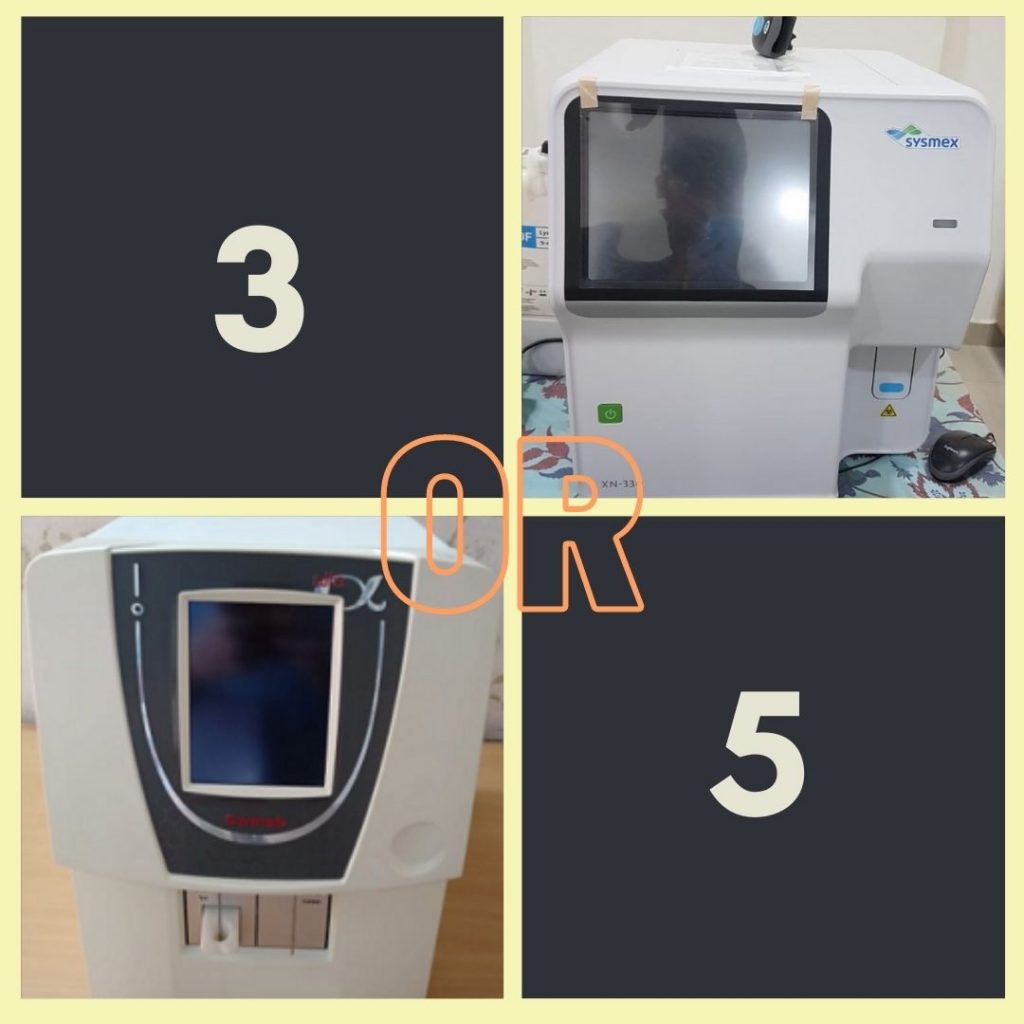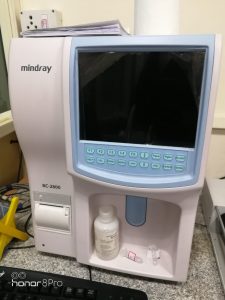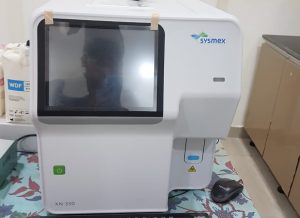
Hematology analyzers are also called cell counters as they are used to make a complete blood count (CBC) including red blood cell (RBC), white blood cell (WBC), hemoglobin, and platelet counts, as well as hematocrit levels and many other parameters. The most common discussion regarding cell counters is around 3-part differential cell counters and 5-part differential cell counters. The difference between a 3-part differential cell counter and 5-part cell counter is that – a 3-part cell-counter reports only 3 types of WBCs (neutrophils, lymphocytes, and monocytes) while a 5-part can differentiate all WBC types (neutrophils, lymphocytes, basophils, eosinophils, and monocytes).
What is a cell counter or hematology analyzer? How does it work?
Coulter’s Principle
All hematology analyzers use Coulter’s Principle. A 3-part differential cell counter uses Coulter’s Principle to determine the size and volume of the cells. Coulter’s principle is applied through the use of two electrodes. Using hydrodynamic focusing, the sample cells are sent through an orifice one cell at a time. As the cells go through the orifice, they briefly cause electrical resistance to the current. This resistance is recorded, measured, amplified, and processed which can then be interpreted by the computer into a histogram.
can then be interpreted by the computer into a histogram.
The 3-part analyzer is able to differentiate between 3 types of WBC’s, neutrophils, lymphocytes, and monocytes. In a 3-part differential cell counter basophils and eosinophils cannot be differentiated and are grouped with population of either neutrophils or monocytes. E.g. Sysmex XP-300 reports neutrophils as a distinct population and group monocytes with the rest. This could be useful for screening bacterial infections. On the other hand Mindray BC – 3000 Plus report Lymphocytes, Granlulocytes and the mixed population of the other WBC components.
Flow Cytometry in 5-part cell counter
A 5-Part Differential Cell Counter utilizes both Coulter’s Principle and flow cytometry to determine the granularity, diameter, and inner complexity of the cells. Just as in 3-part differential cell counter, the sample cells are passed through an orifice. Additionally, during this, a laser is directed at them, and the scattered light is measured at multiple angles. The absorbance is also recorded. The cell can be identified based on the intensity of the scattered light and the level of absorbance. A 5-part cell counter can differentiate all WBC types (neutrophils, lymphocytes, basophils, eosinophils, and monocytes).
6-part differential cell counter
 Recent automated hematology analyzers also come with 6-part differential. They are able to classify immature granlulocytes (IG) as a sixth population and report them as a percentage count of the total WBC count and an absolute count. Presence of IG in peripheral blood indicates increased bone marrow activation, as seen in sepsis. They also report on Reticulocytes, Nucleated RBCs and Fluorescent Platelet counts etc., used for various clinical requirements.
Recent automated hematology analyzers also come with 6-part differential. They are able to classify immature granlulocytes (IG) as a sixth population and report them as a percentage count of the total WBC count and an absolute count. Presence of IG in peripheral blood indicates increased bone marrow activation, as seen in sepsis. They also report on Reticulocytes, Nucleated RBCs and Fluorescent Platelet counts etc., used for various clinical requirements.
5-part or 6-part analyzers are more expensive than 3-part analyzers, but provide more in-depth information about the sample. Specific jobs, such as allergy testing or parasitic infections require 5-part differential analysis. However, most common investigations can be completed with the 3-part analyzer.
Fully automated or semi-automated hematology analyzer?
Fully Automated hematology analyzers are generally intended for use in larger medical facilities or laboratories. The Semi-automated hematology analyzers, are used in small laboratories or as back-up in large hospitals. Tasks like blood sample dilution may not be automated in semi-auto analyzers.
Hematology analyzers or cell counters are the most basic of the laboratory equipment used by hospitals. Popular brands of hematology analyzers in India are Sysmex, Horiba, Mindray, Erba, UBM, Roche, Siemens, Meril etc.
Looking to set-up a Lab?
Here are more resources
For help in budgeting and planning click link below:
https://in.linkedin.com/in/shanthi-mathur-ab07838
